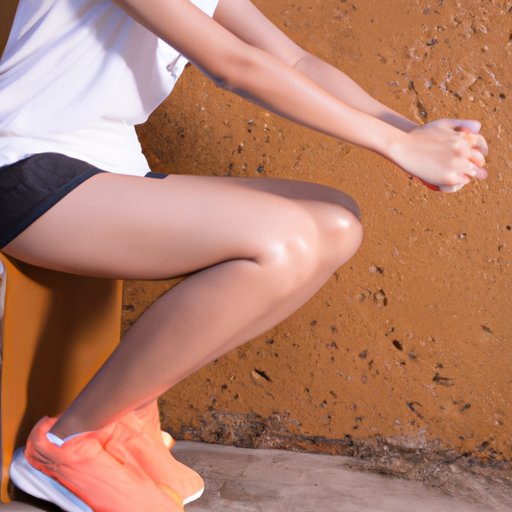Introduction
Wall sits are a type of static exercise that strengthens the lower body and core muscles. This exercise requires no equipment, making it an ideal choice for those who want to improve their fitness and strength at home. By performing wall sits regularly, you can increase your overall mobility, flexibility, and muscular endurance. In this guide, we’ll explore what wall sits are, the various benefits of incorporating them into an exercise routine, and how to perform them properly.

Exploring Wall Sits: An Overview of the Exercise and its Benefits
Wall sits involve holding yourself in a squat position with your back against a wall. Your feet should be shoulder-width apart, and your toes should be pointing forward. You will then slowly lower your body until your thighs are parallel to the ground. Keep your chest up and your core engaged throughout the exercise. This exercise primarily works the quadriceps, hamstrings, glutes, and core muscles.
Wall sits can be modified in several ways depending on your level of fitness. If you’re a beginner, you can start by leaning against a wall and doing a half-squat. As you become more comfortable with the exercise, you can move to a full-squat position. You can also add weight or resistance to the exercise by wearing a weighted vest or holding a medicine ball.
How to Do Wall Sits: A Step-by-Step Guide
To do wall sits correctly, begin by standing with your back against a wall. Position your feet shoulder-width apart and point your toes forward. Then, slide down the wall until your thighs are parallel to the ground. Make sure to keep your chest up and your core engaged throughout the exercise. Hold this position for 30 seconds to 1 minute, then slowly slide back up the wall. Rest for 1 minute before repeating the exercise.
It’s important to maintain proper form and alignment when doing wall sits. Make sure your knees are directly above your ankles and your back is straight against the wall. Don’t let your knees cave inwards as this can cause knee pain. Additionally, avoid arching your back as this puts unnecessary strain on your lower back.

Wall Sits for Beginners: Tips and Techniques
For those who are new to wall sits, it’s important to start slow and focus on proper form. Begin by doing a half-squat against the wall and gradually work your way up to a full-squat position. To make the exercise easier, you can place a pillow or cushion between your back and the wall. This will help reduce the strain on your lower back.
If you find the exercise too difficult, you can modify it by placing your hands on your hips or by using a chair to support your bodyweight. As you become more comfortable with the exercise, you can increase the difficulty by adding a weighted vest or medicine ball. Just make sure to start slow and focus on proper form and alignment.

Wall Sits: The Basics and Beyond
Once you’ve mastered the basics of wall sits, you can start to increase the difficulty level. One way to do this is by increasing the amount of time you hold the position. Start with 30 seconds and gradually work up to 1 minute or longer. You can also add weight or resistance to the exercise by wearing a weighted vest or holding a medicine ball.
Wall Sits: A Comprehensive Guide to Improving Lower Body Strength
Wall sits are an effective way to improve lower body strength. According to a study published in the Journal of Physical Education and Sport, “the wall sit exercise is an effective tool for developing lower body strength and power.” By incorporating wall sits into your exercise routine, you can strengthen your quads, hamstrings, glutes, and core muscles.
In addition to wall sits, you can also incorporate other exercises such as squats, lunges, and step-ups to further strengthen your lower body muscles. Additionally, you can use strategies such as supersets, circuit training, and pyramid sets to maximize your workout.
Maximize Your Workout with Wall Sits
Wall sits are a great way to add a low-impact exercise to your routine. Not only do they target the lower body muscles, but they also provide a challenge for your cardiovascular system. By incorporating wall sits into a full-body workout, you can strengthen your entire body while improving your balance and coordination.
Incorporating wall sits into your routine can also help you achieve your fitness goals faster. A study published in the Journal of Sports Medicine and Physical Fitness found that “including wall sits into a regular exercise program can improve lower body strength and muscular endurance.”
Wall Sits: A Low-Impact Exercise for Increased Core Strength
Not only do wall sits strengthen the lower body muscles, but they also help to strengthen the core muscles. When done correctly, wall sits will engage the abdominals, obliques, and lower back muscles. This helps to improve posture and stability, which can reduce the risk of injury.
To maximize the benefits of wall sits, you can combine them with other core exercises such as planks, crunches, and leg lifts. This will help to further strengthen the core muscles and improve your overall fitness level.
Conclusion
Wall sits are an effective way to strengthen the lower body and core muscles. This exercise is low-impact and can be easily modified for beginners. With proper form and alignment, you can increase your muscular endurance and improve your overall fitness level. By incorporating wall sits into your exercise routine, you can maximize your workout and achieve your fitness goals faster.
(Note: Is this article not meeting your expectations? Do you have knowledge or insights to share? Unlock new opportunities and expand your reach by joining our authors team. Click Registration to join us and share your expertise with our readers.)
